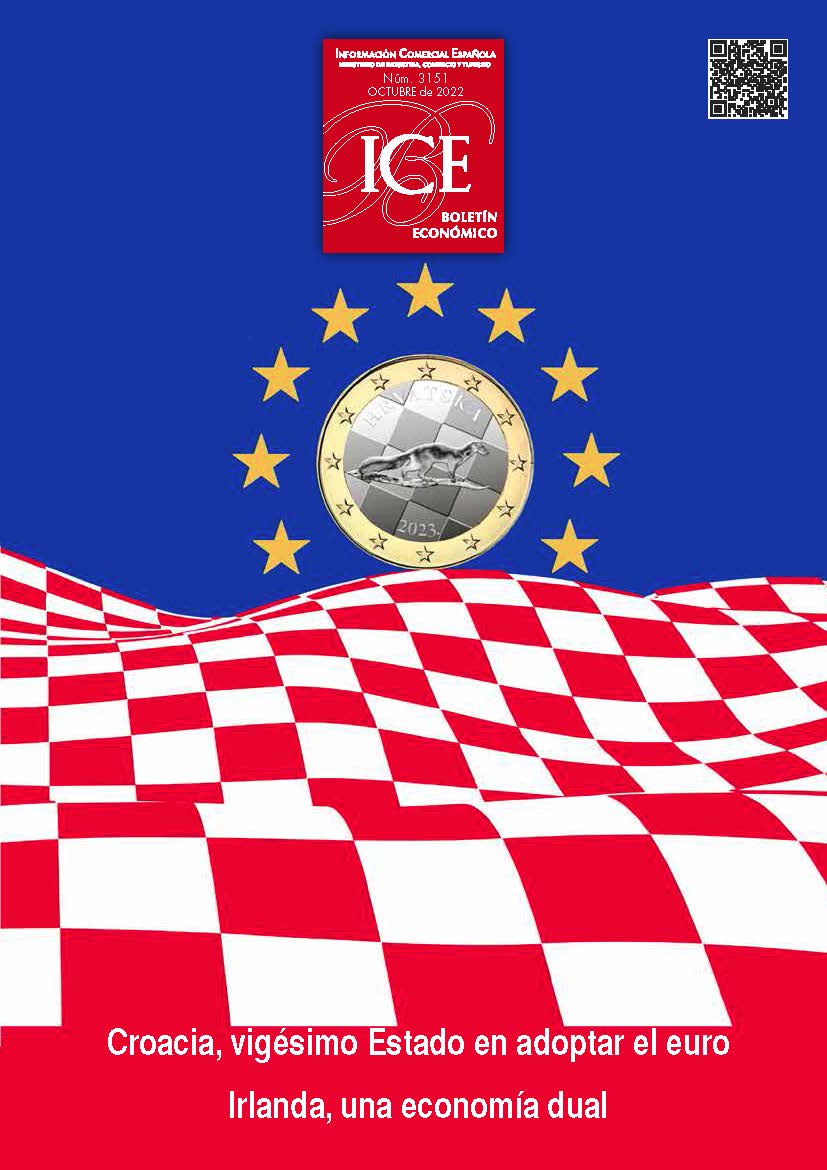Irlanda es una economía dual
##plugins.themes.bootstrap3.article.sidebar##
Descargas
##plugins.themes.bootstrap3.article.main##
En la propuesta de Presupuestos del Estado para 2023 las autoridades irlandesas estiman un PIB (producto interior bruto) para 2022 de 500 mm (miles de millones) de euros. Esto implica un PIB per cápita de casi 100.000 euros. Sin embargo, su cuadro macroeconómico y las ratios de los saldos de balanza de pagos y cuentas públicas utilizan la RNBm _renta nacional bruta, excluidas las actividades de las empresas multinacionales (EM) domiciliadas en Irlanda-. La RNBm se estima en 261mm de euros para 2022, es decir un 52 % del PIB. La RNBm representa el verdadero tamaño de la economía doméstica o indígena irlandesa, y a ella hay que referir el crecimiento de la economía, su comparación con otros países, los saldos de la balanza de pagos y el endeudamiento público y externo. Irlanda es una economía dual. El sector de capital extranjero apenas tiene vínculos con la economía, real y financiera domésticas, y su producción de bienes y servicios se realiza, en un porcentaje muy alto, fuera de Irlanda.
##plugins.themes.bootstrap3.article.details##
Byrne, S., Conefrey, T., & O’Grady, M. (2021). Box C: The Disconnection of GDP from Economic Activity Carried out in Ireland. Quarterly Bulletin, (QB4). Central Bank of Ireland. https://www.centralbank.ie/docs/default-source/publications/quarterly-bulletins/qb-archive/2021/quarterly-bulletin-q4-2021.pdf
Central Bank of Ireland. (2022). Quarterly Bulletin QB3. https://www.centralbank.ie/publication/quarterly-bulletins/quarterly-bulletin-q3-2022
Central Statistics Office. (2022a). Productivity in Ireland 2020. https://www.cso.ie/en/releasesandpublications/ep/p-pii/productivityinireland2020/
Central Statistics Office. (2022b). Goods Exports and Imports July 2022. https://www.cso.ie/en/releasesandpublications/ep/p-gei/goodsexportsandimportsjuly2022/
Central Statistics Office. (2022c). International Trade in Services, Q2, 2022. https://www.cso.ie/en/releasesandpublications/ep/p-na/quarterlynationalaccountsquarter22022/internationaltrade/
Department of Finance. (2018). GDP and modified GNI. Explanatory Note, May 2018. Government of Ireland. https://www.gov.ie/en/publication/498058-gdp-and-modified-gni-explanatory-note-may-2018/
Department of Finance. (2019). Balance of Payments in Ireland: two decades in EMU, August 2019. Government of Ireland. https://www.gov.ie/en/publication/7b9c21-balance-of-payments-in-ireland/
Department of Finance. (2021). Forecasting Modified GNI*, December 2021. Government of Ireland. https://www.gov.ie/en/publication/41891-forecasting-modified-gni/
Department of Finance. (2022a). Budget 2023: Economic and Fiscal Outlook. Government of Ireland. https://www.gov.ie/en/publication/04fef-budget-publications/
Department of Finance. (2022b). Ireland Stability Program Update April 2022. Government of Ireland. https://www.gov.ie/en/publication/1ca1d-draft-stability-programme-update-2022/
Department of Finance. (2022c). The Dual Structure of the Irish Economy – Further Evidence from sectoral accounts. June 2022. Government of Ireland. https://www.gov.ie/en/publication/58542-the-dual-structure-of-the-irish-economy-evidence-from-the-sectoral-accounts/
Department of Enterprise, Trade and Employment. (2022). Annual Business Survey of Economic Impact (ABSEI) 2020. Government of Ireland. https://enterprise.gov.ie/en/publications/annual-business-survey-of-economic-impact-2020.html
Di Ubaldo, M., Lawless, M., & Siedschlag, L. (2018). Productivity spillover from multinational activity to local firms in Ireland (OECD Productivity Working Papers n.º 16). https://doi.org/10.1787/58619717-en
European Commission. (2022). In-depth review for Ireland (Commission Staff Working Document 2022 - 634 final). https://economy-finance.ec.europa.eu/economic-and-fiscal-governance/macroeconomic-imbalances-procedure/depth-reviews_en#ref-2022-idrs
FitzGerald, J. (2022, June 10). Government should put some of the corporate tax windfall into a rainy day fund. The Irish Times. https://www.irishtimes.com/business/2022/06/10/government-should-put-some-of-the-corporate-tax-windfall-into-a-rainy-day-fund/
Honohan, P. (2021). Is Ireland really the most prosperous country in Europe? Economic Letter, 2021(1). Central Bank of Ireland. https://www.centralbank.ie/docs/default-source/publications/economic-letters/vol-2021-no-1-is-ireland-really-the-most-prosperous-country-in-europe.pdf
IDA Ireland. (2022a). Annual Report 2021. https://www.idaireland.com/annual-reports
IDA Ireland. (2022b). Facts about Ireland 2021. https://www.idaireland.com/latest-news/publications/facts-about-ireland-2021
International Monetary Fund. (2022). Ireland: 2022 Article IV Consultation-Press Release; Staff Report and Informational Annex. https://www.imf.org/en/Publications/CR/Issues/2022/07/07/Ireland-2022-Article-IV-Consultation-Press-Release-Staff-Report-and-Informational-Annex-520463
Irish Fiscal Advisory Council. (2018). Underlying Measures of the Irish Economy. Issues with interpreting Irish economic data. https://www.fiscalcouncil.ie/wp-content/uploads/2018/11/Box-C.pdf
Irish Fiscal Advisory Council. (2022). Fiscal Assessment Report. May 2022. https://www.fiscalcouncil.ie/fiscal-assessment-report-may-2022/
Podpiera, J. (2017). Ireland: The role of foreign-owned multinational enterprises. IMF Country Report, (17/172), 40-63. https://www.imf.org/en/Publications/CR/Issues/2017/06/26/Ireland-Selected-Issues-45007


